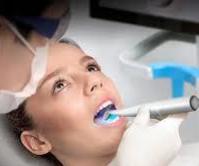Benefits of Intraoral Scanners for Dentists
Posted on 3rd June 2019 at 11:20
June 2019
Intraoral scanning technology is:
quick and easy to use,
more accurate, resulting in fewer remakes,
ends the need for posting impressions,
adds interest to a dentists workflow!
If like me you were at the Dental Technology Showcase at the NEC in May, you will have seen that 3D and scanning technology is the biggest game changer in dentistry in the next 2-3 years. We are already using this technology, and hope that dentists will join us on this journey.
Now is a great time for dentists to start on their digital journey by investing in an intraoral scanner. The prices have dropped significantly in the last three years and they are now much smaller, mainly cordless and powder is a thing of the past!
We are seeing an uptake in use of scanners by dentists as this is now tried and tested technology. Intraoral scanning can be used for: crown & bridge work, orthodontic work (e.g. aligners, retainers and wire work), implants, and even bite splints.
Whether a small, medium or large practice, you can access this technology. One intraoral scanner can be shared in most practices.
The key benefits and reasons for adopting this technology include:
• a scan can be sent whilst the patient is in the chair so any issues can be identified immediately
• scans are more accurate than analogue impressions, resulting in fewer remakes and less surgery time for you
• taking fewer analogue impressions,
• the need for post/courier will be gone



Some of the manufacturers may try and sell you 3D scanners and printers and will claim that this will save you dental lab fees and mean you can produce your own crowns within an hour. If you choose to go down this route, particularly if you are a large practice, we wish you well. Personally, I don’t feel the technology will lead to the end of dental labs as:
• the investment is very high for a dental practice and the labs have made this investment already. Repayment for a practice would take many years
• although you can save on dental lab fees there will be an increase in the time spent in your surgery making the design, milling and finishing a crown
• sintering time has reduced from 24-6 hours at labs, but the short sinter cycle for practices means the crown work looks opaque and featureless as it doesn’t have the required time to become translucent
At this point in time, my recommendation to dentists is:
• start discussing the use of an intraoral scanner in your practice. I really don’t think this is a fad and patients will shortly come to expect this
• get quotes from a range of different suppliers and enquire about their deals for outright purchases, leasing schemes, and what training and support is available within the price. (Making use of the training and support can be key to the speed with which you become adept in using the technology). Websites such as Dental Scanners UK are good for helping you ask the right questions before purchasing!
• fully check out any offers of free scanners as they are often linked to longer term contracts and may mean you spend more in the long term
I wish you well exploring this technology. I have certainly found it very interesting to use and it makes workflows more fun!
As always, if you have any queries about this blog please contact me via our website or give us a call.
Giles Bradley

Share this post:
